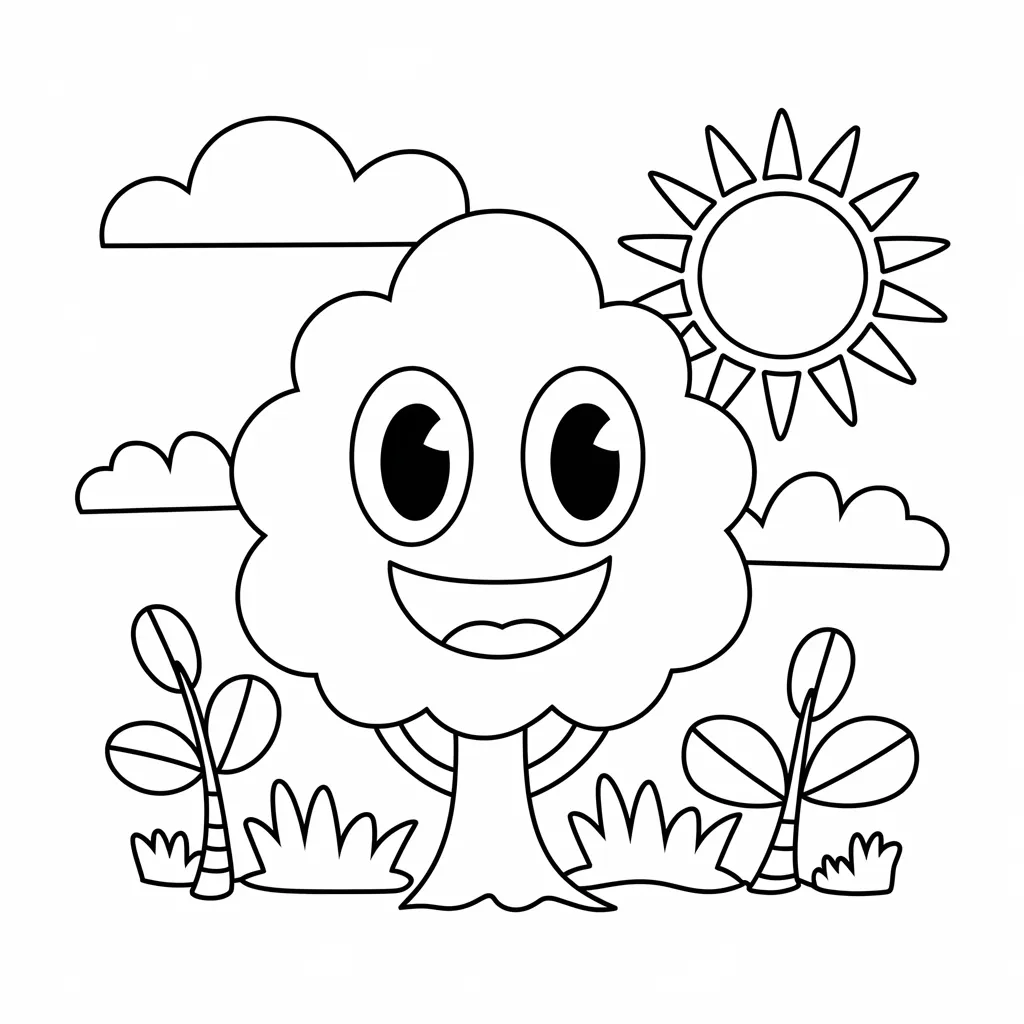Trees for All Seasons
Trees change throughout the year, making them perfect subjects for coloring pages. Spring trees burst with tiny green leaves and colorful blossoms. Summer brings full, leafy canopies offering cool shade. Fall transforms trees into spectacular displays of red, orange, and gold. Winter reveals beautiful bare branches, sometimes dusted with snow. Tree coloring pages let children explore these seasonal changes, helping them understand nature's cycles while having fun. Parents and teachers often select pages matching the current season, creating a connection between what kids see outside their windows and what they're coloring. This seasonal approach makes tree coloring pages relevant year-round and offers endless variety.
Mighty Oak Trees
Oak trees stand as symbols of strength and endurance, making them popular subjects for coloring pages. These magnificent trees with their distinctive lobed leaves and acorns offer wonderful details for young artists to color. Oak tree coloring pages often showcase their impressive size, with branches spreading wide across the page. Some pages feature close-ups of acorns and oak leaves, helping children recognize these features on real trees during nature walks. Many oak tree coloring pages include woodland creatures like squirrels gathering acorns or birds nesting in branches. The oak's status as a national tree in many countries also makes these coloring pages useful for cultural and environmental lessons, connecting art time with broader learning about our natural heritage.
Magical Forest Scenes
Forest coloring pages transport children to enchanted worlds filled with trees. These pages often feature dense woodland scenes where multiple trees create a magical setting. Some pages take a realistic approach, showing diverse forest ecosystems with various tree species growing together. Others embrace fantasy, with faces hidden in tree trunks or fairy homes nestled in roots and hollows. Children love coloring these immersive scenes, adding their own touches to create unique forest worlds. These pages encourage storytelling as kids imagine who might live in their colored forest or what adventures might happen there. Many parents report that forest coloring pages keep children engaged longer than simpler designs, as there's always another tree, plant, or forest creature to discover and color.
Palm Trees and Beaches
Palm tree coloring pages bring tropical vibes to coloring time. These distinctive trees with their tall trunks and fan-like fronds offer a different coloring experience from deciduous trees. Beach scenes featuring palm trees, ocean waves, and perhaps a hammock strung between two trunks are especially popular. Children enjoy coloring these sunny scenes, often using bright blues for the sky and water, vibrant greens for the palms, and warm yellows for sandy beaches. For families planning tropical vacations, palm tree coloring pages can build excitement before the trip. They're also perfect for winter coloring sessions when kids need a mental escape to somewhere warm and sunny. These pages introduce children to different tree types from around the world, expanding their understanding of diverse environments.
Fruit Trees in Bloom
Fruit tree coloring pages combine the beauty of trees with the appeal of favorite foods. Apple, cherry, orange, and other fruit trees offer colorful possibilities beyond just green leaves and brown trunks. Pages showing trees in various stages – from spring blossoms to summer fruit – help children understand how food grows. Many fruit tree coloring pages include details like ladders for picking, baskets of harvested fruit, or birds and insects visiting the trees. These pages naturally lead to conversations about where food comes from, making them educational as well as artistic. Some collections feature orchard scenes with multiple fruit trees, allowing children to use different colors for various fruits. These pages are especially popular during harvest seasons or when studying food topics in school.
Ancient Trees and Giants
Coloring pages featuring ancient trees like redwoods, sequoias, and baobabs fascinate children with their massive scale and unique shapes. These pages often include people or animals near the trees to show their impressive size. Some pages focus on famous individual trees like General Sherman or the Dragon Blood Tree. Children are naturally drawn to these extraordinary trees that seem almost magical in their proportions and longevity. Coloring these giants offers opportunities to discuss conservation, the concept of time, and the importance of protecting old-growth forests. Pages showing the inside rings of ancient trees can introduce concepts like tree age and climate history. These coloring activities inspire wonder and respect for nature's oldest living things, sometimes sparking a lifelong interest in environmental stewardship.
Tree Homes and Habitats
Trees provide homes for countless creatures, making tree habitat coloring pages both fun and educational. These detailed pages show birds nesting in branches, squirrels in hollow trunks, insects under bark, and other animals making their homes in different parts of trees. Some pages focus on specific habitats like rainforest canopies or deciduous woodland understories. Children learn about ecosystems while enjoying the creative process of coloring. These pages naturally prompt conversations about wildlife and how different species depend on trees. Some habitat coloring pages include labels identifying animals and their tree homes, adding an educational element. Parents and teachers appreciate how these coloring activities combine art, science, and environmental awareness, helping children understand the interconnectedness of living things.
Fairy Tale Trees
Trees from beloved fairy tales and stories make magical coloring subjects. From enchanted forests to specific trees like the beanstalk from Jack and the Giant or the talking trees from The Wizard of Oz, these pages connect coloring time with literary adventures. Many fairy tale tree pages feature whimsical elements like faces in the trunks, doors leading to hidden worlds, or branches shaped into staircases and platforms. Children delight in bringing these imaginative scenes to life with color. Some pages reference specific stories, while others simply capture the essence of magical trees, allowing kids to invent their own tales. These coloring activities encourage creativity and often inspire children to write or tell stories about their colored creations. Parents find that these pages build connections between reading, imagination, and artistic expression.
Life Cycle of Trees
Tree life cycle coloring pages illustrate how trees grow from tiny seeds to towering plants. These educational pages often show several stages on one sheet – seeds, seedlings, saplings, mature trees, and sometimes fallen logs returning to the soil. Some pages include labels identifying parts like roots, trunk, branches, and leaves. The progression shown helps children understand growth and life cycles in nature. These coloring activities often accompany school lessons about plants, making abstract concepts more concrete. Some life cycle pages focus on specific tree types, showing how acorns become oaks or pine cones produce evergreens. Parents and teachers value these pages for their combination of science and art, reinforcing learning through creative engagement. Children gain satisfaction from coloring the entire life story of a tree, building appreciation for these important plants.
Benefits of Tree Coloring
Beyond just being fun, tree coloring pages offer numerous benefits for children and adults alike. The natural patterns of leaves, bark, and branches help develop fine motor control as colorists follow these organic lines. The subject matter connects children with nature, something increasingly important in our digital world. Tree coloring pages can be simple enough for beginners or complex enough for advanced colorists, making them appropriate for various skill levels. Many people find coloring trees particularly relaxing, perhaps because of our innate connection to nature. These pages offer seasons of coloring possibilities and complement outdoor learning experiences. For classrooms, tree coloring activities support units on environment, seasons, plant biology, and ecosystems. Whether used for educational purposes, creative expression, or simply quiet enjoyment, tree coloring pages root children in the natural world while nurturing their artistic development.
Frequently Asked Questions
- → What age group are tree coloring pages best for?
- Tree coloring pages are versatile for all ages. Simple outline trees with few details work well for toddlers and preschoolers developing motor skills. Elementary children enjoy more detailed forest scenes and seasonal trees. Intricate designs showing tree habitats or elaborate pattern-filled trees challenge older children and adults. Since trees come in countless varieties and settings, there's a tree coloring page to match any age or skill level.
- → How can I use tree coloring pages educationally?
- Tree coloring pages offer numerous educational opportunities. Use seasonal tree pages to discuss weather patterns and annual cycles. Life cycle pages teach plant growth and biology concepts. Habitat pages introduce ecosystem relationships and animal homes. Ancient tree pages can spark discussions about history, time, and conservation. Fruit tree coloring promotes learning about food sources. Try pairing coloring with outdoor tree identification walks to connect paper trees with real-world experiences.
- → What's the best way to color tree trunks and leaves?
- For realistic trees, use browns ranging from light tan to dark chocolate for trunks and branches, adding texture with small strokes to mimic bark. Leaves offer more variety – spring leaves are light yellow-green, summer leaves are deeper green, and fall brings oranges, reds, and yellows. Try layering colors for depth, starting with lighter shades and adding darker tones. For creative expression, encourage children to explore non-traditional colors like purple trunks or rainbow leaves. Different tools create different effects – colored pencils for detail, crayons for texture, and watercolors for dreamy forest scenes.
- → Can tree coloring pages help with seasonal depression?
- Many people find tree coloring pages therapeutic, especially during winter months. Coloring bright spring or summer tree scenes can provide a mental escape during darker seasons. The repetitive, meditative quality of coloring tree elements like leaves or bark helps reduce stress and anxiety. Nature-themed coloring has been shown to improve mood and create feelings of connection to the outdoors even when weather prevents actual outdoor time. Try setting aside regular coloring sessions with seasonal tree pages as a simple self-care practice during challenging months.
Conclusion
Tree coloring pages bring the majesty and diversity of nature to life through engaging, creative activities for all ages. Our collection celebrates trees in every form – from seasonal displays showcasing spring blossoms, summer shade, autumn colors, and winter silhouettes to specific varieties like mighty oaks, tropical palms, and ancient redwoods. Children particularly love our enchanted forest scenes, fairy tale trees with magical elements, and habitat pages revealing the many creatures making their homes among branches and roots. Educational offerings include fruit tree pages showing how food grows and life cycle illustrations tracking development from seed to towering tree. These printable coloring pages connect children with nature while developing fine motor skills, encouraging observation, and fostering environmental appreciation. Whether used in classrooms to support science curriculum, at home for quiet creative time, or during nature programs, tree coloring pages root children in the natural world while nurturing their artistic growth.
 Pin it
Pin it
